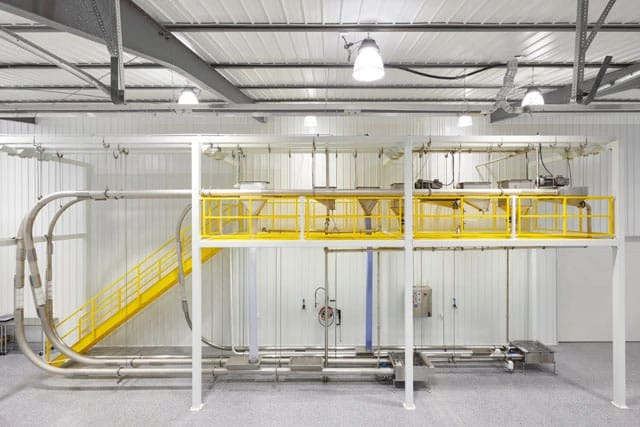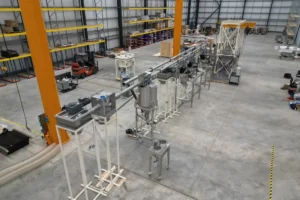In food manufacturing, general safety requirements are shaped in a way that protects the physical, chemical, and sanitary integrity of food ingredients and products. So, what are the FDA regulations for frozen food packaging? In this blog, we’ll go over all the requirements set out by the agency, ensuring your frozen food production and processing facilities operate safely and according to government regulations.
The FDA regulations for frozen food packaging ensure that materials are safe and non-toxic. Labels provide accurate nutritional and ingredient information, storage and handling instructions are clear, and tamper-evident measures are in place to protect product integrity.
Why It’s Important to Be Aware of FDA Regulations for Frozen Food Packaging?
In the food industry, where products often move through an industrial conveyor belt system to streamline production, maintaining the safety and health of consumers is paramount. One critical way to achieve this is by adhering to the regulations set by authoritative bodies like the US Food and Drug Administration (FDA). But why are these FDA regulations, especially for frozen food packaging, so crucial? Let’s unpack the reasons:
- Consumer safety and health – Proper packaging prevents potential contaminants from reaching the food, ensuring that it remains safe for consumption. The FDA ensures that materials used in packaging do not leach harmful substances into the food, particularly during the freezing process.
- Informed decision-making – Regulations require comprehensive and truthful labeling, allowing consumers to know exactly what they’re consuming, from ingredients to nutritional values. The presence of allergens must be declared, which is vital for individuals with food allergies or sensitivities.
- Economic considerations – Avoid recalls that can be costly and damage a brand’s reputation. Complying with FDA regulations reduces the risk of having to recall products due to packaging issues. Adhering to FDA standards can be beneficial for businesses looking to export products internationally, as many countries respect and recognize these guidelines.
- Upholding brand reputation – Companies that follow FDA regulations are viewed as responsible and trustworthy in the eyes of consumers. Consistent adherence to regulations ensures that products meet a certain quality standard each time.
- Legal implications – Non-compliance can lead to legal challenges, fines, or even business closure. Being aware of and following the regulations keeps businesses on the right side of the law. Also, consistent adherence is often essential to retain food production and sales licenses.
- Environmental responsibility – The FDA often evaluates the environmental impact of packaging materials. Adhering to their guidelines can indirectly promote environmental sustainability.
- Future-proofing the business – The food industry is ever-evolving. By staying informed about FDA regulations, businesses can adapt to changes, whether it’s the introduction of new packaging technologies or shifts in consumer behavior.
What Are The FDA Regulations for Frozen Food Packaging?
The US Food and Drug Administration (FDA) has several regulations and guidelines that relate to the packaging of frozen foods. Within the process, the belt conveyor system plays an instrumental role in transporting and ensuring that these products are handled efficiently and hygienically. The primary purpose of these regulations is to ensure that food products are safely packaged, labeled, and managed to minimize potential health risks to consumers.
The Multifaceted Benefits of Food Packaging: From Safety to Marketing
Food packages offer a variety of benefits to manufacturers and consumers alike. It is a vital element of food safety because it protects products from outside contamination and prolongs shelf life. It also has significant marketing advantages since a familiar or exciting design quickly catches the eye and leads to purchase.
Moreover, detailed nutrition labeling offers invaluable information about the product to potential consumers, such as which major food allergens it contains, nutrition facts, an ingredient list, and how it should be prepared and consumed. Understanding this consumer safety guidance is crucial to packaging your frozen food in a safe, effective, and legally compliant manner.

Criteria for Substance Approval: Balancing Analytical Data With Public Health Concerns in Food Packaging
In the realm of bulk material handling equipment, which often deals with large volumes of substances for various applications, a substance can be cleared for food packaging based on its analytical chemistry data and how likely it is to present a public health concern. If a substance represents no cause for toxicological concern (as judged by the FDA), it can be incorporated into this process.
Overall, it should have the following essential characteristics:
- Resistance to low and high temperatures (especially if the food is cooked in its original packaging),
- Have a particular mechanical strength,
- Resistance to acid, oil, and other degrading chemicals in the food product,
- A specific level of hygiene.
An Oversight on Food Contact Substances
To ensure that food contact articles, including food processing and packaging equipment, are safe for use, the FDA established the Division of Food Contact Substances. This division is within the Office of Food Additive Safety, Center for Food Safety and Applied Nutrition (CFSAN).
A food contact substance (FCS) refers to any substance designed to be a component in materials used for making, packaging, transporting, or storing food without the intention of altering the food in any technical way. FCSs are typically found in materials like plastics, coatings, paper, colorants, adhesives, antimicrobials, and antioxidants. The FDA has established a program known as the Food Contact Notification (FCN) program to assess these FCSs.
Navigating the FDA’s Food Contact Substance Notification: Procedures and Implications
Federal food laws dictate that any company that wishes to supply or manufacture an FCS must submit an FCN program to the FDA. “Supply” in this case includes any organization or individual supplying the FCS, even those that are supplying it only for themselves for manufacturing food contact material.
Once an FCN has been filed, the FDA has 120 days to respond. If it doesn’t object to the substance or fails to respond in the given time, the FCS can legally be used in food product manufacturing. Once an FCN program is in effect, it applies only to the FCS the Notification was for, as well as only to the food processor listed in the notification.

Decoding the Labeling Requirements
Understanding labeling requirements for frozen foods is vital for both consumer safety and informed choice. Labels consistently follow strict standards. These prominently display the product name, a comprehensive list of ingredients, essential nutrition facts, net quantity, and detailed information about the manufacturer, packer, or distributor.
Furthermore, thanks to the Food Allergen Labeling and Consumer Protection Act (FALCPA), allergen labeling is mandatory, aiding individuals with allergies in making safe choices. Additionally, the Nutrition Labeling and Education Act (NLEA) mandates that most foods, including frozen ones, showcase their nutritional content, ensuring transparency for consumers about their dietary intake.

Ensuring Safety and Transparency: FDA’s Rigorous Standards for Frozen Food Packaging
When it comes to frozen food packaging, the FDA places strict regulations on several fronts. Health and nutrient claims on packages must be accurate and not misleading, ensuring that terms like “low fat” or “high in fiber” align with the FDA’s official definitions. Additionally, certain products require explicit storage instructions for safety, leading to labels such as “Keep frozen” or directives like “Must be cooked from frozen.”
It’s also crucial for items that are raw or only partially cooked to have clear handling and cooking guidelines, as these help mitigate the risk of foodborne illnesses. Lastly, the FDA enforces the use of tamper-evident packaging for specific products before putting them on a conveyor belt for food, bolstering consumer confidence in the safety and integrity of their choices.

FCSs vs. Food Additives
The FDA’s definition of an FCS includes a wider variety of substances that come in contact with foods than those regulated as food additives. In the past, the FDA had several categories of additives:
- Direct additives – those with an intended technical effect on food.
- Secondary direct additives – with an intended technical effect during processing but not in the finished food product.
- Indirect additives – with an intended technical effect in food contact material (not the food).
This is largely an informal classification of additives. These definitions don’t exist in the codified regulations or the statute, though they are mentioned separately in the Code of Federal Regulations. Only FCSs that are also food additives (of any category) require approval from the FDA before they reach the market. Most FCNs submitted will be about substances that belong in the third category – indirect additives.
Other FCSs to Be Aware Of
FCNs can also be compounds that are not food additives in any way. They are sorted into several groups, including GRAS, prior sanctioned, and no-migration substances.
Accordion
GRAS
GRAS stands for “generally recognized as safe.” GRAS substances reach their status based on the type of information available about them and the general opinion of the scientific community. The information that supports the GRAS conclusion must be the same in quality and quantity as information that would support the safety of an additive.
Direct additives covered by the GRAS category can also be used for indirect food contact applications, such as in packaging materials. Examples of that include zinc stearate and zinc oxide.
Prior Sanctioned
The packaging was included in the FDA back in 1958. Before this, the FDA had already approved many substances for use in food contact materials. All substances that have received this letter of FDA approval before 1958 fall in the “prior sanctioned” group of substances.
A well-known example of this is PVC. However, food manufacturers should still be careful even when using prior sanctioned FCSs. Many other FDA sections require guaranteed safety of product packaging material before placing it on the market.
No-Migration Substances
If a substance does not become a food component (in reasonable quantities), it is not considered an additive but could still be approved as an FCS. However, proving that a substance does not migrate into food is not an easy task. The consensus is that the migration threshold level is less than 50 ppb (parts per billion).
High-exposure applications, such as the material of milk and carbonated beverage bottles, have a limit of 10 ppb. The no-migration substances category does not apply to known carcinogens or toxic substances, such as heavy metals. It also does not apply to substances that are toxic to humans or animals in levels equal to or lower than 40 ppb.
End of Accordion
Ensure You Check All the Sanitary Regulations
If you’re a frozen foods producer with a custom conveyor belt, you must keep in mind the strict sanitary regulations that apply. The contamination has to be avoided at all costs. The responsibility for the integrity and sanitation of the packaging does not stop with its production. Your food containers and packaging materials must be stored away from cleaning chemicals, odorous materials, pesticides, or any other type of compound that is not safe.
The utmost care must be taken to ensure that transferring packaging substances and materials from one side of the production facility to another is contamination-free. The conveyor belts you use must not have metal parts, loose pieces, string, rope, clips, or anything else that might find its way into the final product. Enclosed conveyor systems for transporting material are the most efficient way of keeping your product ingredients safe from outside contamination.

Choose the Best Transportation for Your Frozen Foods With Cablevey Conveyors
In the ever-evolving world of frozen foods, selecting the right transportation method, including an efficient conveyor belt for warehouse logistics, is paramount. Cablevey Conveyors ensures that your products not only retain their quality but are also moved seamlessly, safely, and in an eco-friendly manner through these conveyor systems. No longer should you compromise on the integrity of your frozen goods during transport. With Cablevey, you’re investing in the future of your products, making sure they reach their destination as fresh as they were when they left. Ready to elevate your transportation strategy? Don’t wait – contact us today and embark on a journey of seamless and effective frozen food transportation.






